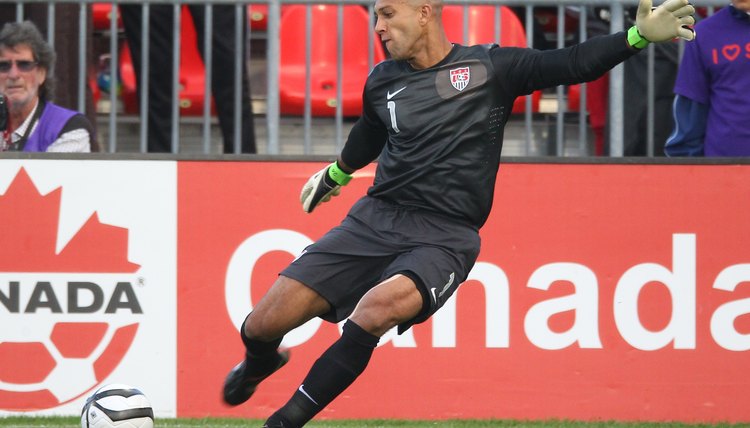How to Improve Your Goal Kick

In soccer, a goal kick is awarded to the defending team if the ball is played over its goal line -- but not through the goal -- by the opposing team. The kick can be taken by any team member from any spot inside the 6-yard box but is usually taken by the goalie. A goal kick gives the defending team a chance to move the ball back up the field. Maximize this opportunity by improving your goal kick.
Placement
A well-executed goal kick is wasted if you do not place it properly. Take your time to find a player in an open position. Ideally, the player should not have a defender on the side closest to you. If no player is open, don't kick the ball. Call to your players, letting them know that you have no options. When they open up for you, place the ball to them, keeping in mind that you should place the ball to the spot where the player will be -- not where he is at the moment of the kick.
Approach
Approach the ball from an angle. If you're kicking with your right foot, approach slightly from the left and vice versa. This allows you to use the power of your hip flexors -- muscles located at the top of your thigh bone. Keep a long, even stride. This will help you gather speed and to strike the ball with a smooth, swift kick.
Kick
Plant your non-kicking foot beside the ball and lean back. Because you have time during a goal kick, kick with your better foot if one is stronger than the other. When shooting, you would place your body over the ball, but when going for distance -- rather than pure power -- your body should be back. This will help create the upward trajectory that you need to create distance with your kicks.
Contact
The final and most important part of the goal kick is the moment of contact. How you connect with the ball will affect its direction and force. Point your toe outward with the ankle locked. Strike the ball with you instep, hitting the ball with the side of your laces just above your big toe. As you make contact with the ball, you should be striking it upward -- chipping it into the air.
Building Leg Strength
The power of your goal kicks can be improved by increasing your leg strength. According to "The Best of Soccer Journal: An NSCAA Guide to Soccer Coaching Excellence," exercises that involve the hamstrings are key to building leg strength. Plyometrics -- a type of exercise that involves explosive jumping movements -- can build this strength. You can also improve the strength of your hamstrings with resistance exercises, in which you push and pull your legs against the tension of a resistance band. Simple lunges can also build the strength in your hamstrings and require no additional equipment.
References
- Soccer Training Guide: Soccer Goal Kick in 5 Steps
- JB Goalkeeping: Distribution
- Soccer: Steps To Success; Joe Luxbacher
- The Best of Soccer Journal: An NSCAA Guide to Soccer Coaching Excellence; Jay Martin
